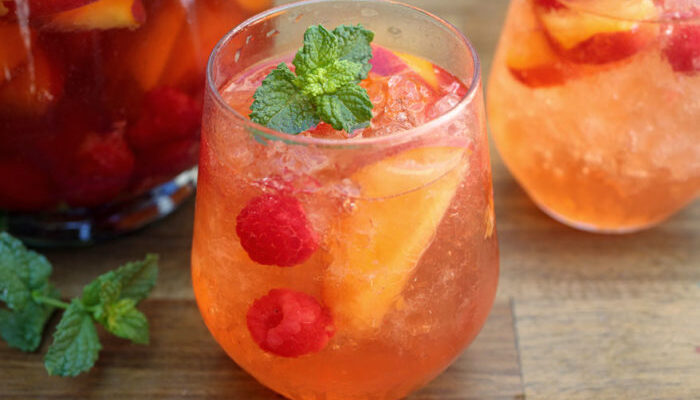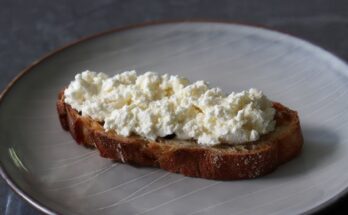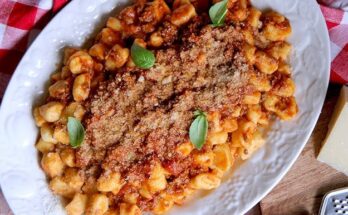Red Wine Sangria Recipe: Looking for a delicious, easy-to-make, and crowd-pleasing drink? Red wine sangria is the answer. This classic Spanish beverage combines the richness of red wine with the zesty brightness of fresh fruits, the sweetness of sugar or juice, and just the right splash of spirits for a refreshing and slightly boozy finish. Whether you’re hosting a summer party, holiday gathering, or just looking to unwind with something tasty, red wine sangria checks every box.
Let’s dive into a complete, step-by-step guide that not only lists the ingredients and tools you need but also walks you through each stage of making the perfect sangria. This isn’t just any recipe — it’s your go-to guide to crafting a punch bowl masterpiece.
A Brief History of Sangria
Sangria traces its roots back to Spain and Portugal, dating as far back as the 18th century. The term itself is derived from the Spanish word “sangre,” meaning blood, referring to the drink’s deep red hue. Traditionally, sangria was made using red wine, water, herbs, spices, and fruits — often as a means to improve the taste of cheaper wines.
Back then, sangria was a rustic, countryside staple — a way to use seasonal fruits and affordable table wine. Over the centuries, it evolved into a more refined, globally beloved beverage. Today, it’s served in trendy restaurants and backyard BBQs alike, with countless variations across the world. Despite these twists, red wine remains the heart and soul of the original sangria recipe.
Why Red Wine Sangria is a Crowd Favorite
There’s just something irresistible about red wine sangria. Maybe it’s the bold flavors. Maybe it’s the juicy fruits that soak up the wine. Or maybe it’s the customizable nature of the drink — you can tweak it to suit any palate or occasion.
- It’s Refreshing: Despite being made from red wine, sangria is light and fruity, making it ideal even for warm weather.
- It’s Versatile: You can use different fruits, wines, and sweeteners depending on your taste.
- It’s Economical: You don’t need expensive wine. In fact, inexpensive red wine often works better because you’re mixing in other flavorful ingredients.
- It’s Fun: Let’s face it — a big pitcher of sangria just looks festive and makes people happy.
It’s the kind of drink that invites conversation, laughter, and a second glass.
The Perfect Occasions to Serve Sangria
Sangria fits almost any occasion. Whether it’s a casual weekend brunch or an elegant dinner party, this drink brings charm and cheer.
Here are some ideal moments to serve it:
- Summer BBQs & Pool Parties – It’s cold, fruity, and oh-so-refreshing.
- Holiday Gatherings – Add some cinnamon sticks and cranberries for a festive touch.
- Dinner Parties – It works wonderfully with Spanish or Mediterranean dishes.
- Date Nights or Self-Care Evenings – One glass is pure joy after a long day.
Honestly, there’s never a wrong time for a good sangria.
Ingredients You’ll Need
Let’s break down everything you’ll need to create your ultimate red wine sangria. This isn’t just a throw-it-in-the-pitcher kind of drink. Each ingredient plays a specific role in building that signature sangria flavor.
Choosing the Right Red Wine
Your sangria’s base should be a dry, fruity red wine. Don’t use your expensive vintage here — sangria is all about using a decent, affordable bottle. You want something bold, not too tannic, and definitely not too sweet.
Top Choices:
- Tempranillo – Spain’s classic sangria grape. Medium-bodied and perfect for sangria.
- Garnacha (Grenache) – Another Spanish varietal that’s juicy, fruity, and light.
- Merlot – Smooth and accessible.
- Zinfandel – For a fruitier, spicier profile.
- Cabernet Sauvignon – Works in moderation if balanced with sweeter fruits.
Avoid: Super dry, tannic wines like Barolo or Chianti.
Fresh Fruits to Include
Fruits aren’t just for decoration. They infuse the sangria with flavor and soak up the wine, creating a juicy burst in every bite. Traditional fruits include citrus and stone fruits, but feel free to experiment!
Must-Have Fruits:
- Oranges – Add citrus brightness.
- Lemons/Limes – For acidity and balance.
- Apples – Provide texture and absorb wine beautifully.
- Berries – Strawberries, raspberries, or blueberries for a summer twist.
- Peaches or Nectarines – Offer a soft, aromatic layer.
Pro Tip: Avoid bananas or melons — they can turn mushy and overpower the drink.
Sweeteners and Spices
A touch of sweetness balances the acidity of wine and fruit. You can use various types, depending on your preference.
Popular Sweeteners:
- Simple Syrup – Easy and neutral.
- Honey – Adds floral notes.
- Maple Syrup – Rich and deep, good for fall sangria.
- Orange Juice or Apple Juice – A natural, juicy sweetness.
Spices (Optional but Flavorful):
- Cinnamon Sticks
- Star Anise
- Cloves (sparingly)
These give a warm, spicy kick — especially during cooler months.
Optional Add-ins and Twists
Want to get a little adventurous? Try these optional add-ins for a fun variation:
- Brandy – The most traditional spirit used in sangria.
- Triple Sec or Orange Liqueur – Boosts citrus flavor.
- Club Soda or Sparkling Water – For a fizzy finish.
- Red Vermouth – Adds complexity.
- Mint Leaves – For a burst of freshness.
Mix and match to find your signature blend.
Essential Tools and Preparation Tips
To make the perfect red wine sangria, you don’t need fancy gadgets — just a few essentials and some prep time.
Kitchen Tools You’ll Need
Make sure your kitchen is stocked with these simple tools:
- Large Pitcher or Jug (at least 2 liters)
- Wooden Spoon (for gentle mixing)
- Sharp Knife & Cutting Board
- Citrus Juicer (optional, but useful)
- Measuring Cups & Spoons
- Wine Glasses or Tumblers
- Fine Mesh Strainer (if removing pulp or spices)
Keep it simple — sangria should be easy, not complicated.
Prepping Your Fruits Properly
Your fruits are the stars of the show, so treat them right.
- Wash thoroughly — Especially citrus, as you’ll be using the peel.
- Slice thinly — Thin slices infuse faster and look beautiful in the glass.
- Keep the skins on — They add flavor and color.
- De-seed when needed — No one wants a mouthful of seeds.
- Use fresh fruit — Not frozen or canned, which can water down the sangria.
Pro tip: You can muddle (gently mash) some of the fruits before adding for extra flavor extraction.
Chilling Time – Why It Matters
Sangria isn’t meant to be made and served right away. It needs time to infuse.
- Minimum Time: 2 hours
- Ideal Time: 12–24 hours in the fridge
- Maximum Time: 48 hours — after this, fruits may become soggy
Why wait? The longer the ingredients sit together, the more the flavors marry into one perfect sip.
Step-by-Step Guide to Making Red Wine Sangria
This is where the magic happens. With all your ingredients and tools ready, it’s time to create your delicious red wine sangria. Follow these simple steps for a pitcher that’s sure to impress.
Step 1: Select and Pour Your Wine
Begin with a bottle of red wine that’s fruity and smooth—Merlot, Rioja, or Zinfandel work perfectly. Pour the wine into a large glass pitcher, leaving space for fruits and mixers to join the party.
Step 2: Chop and Add the Fruits
Slice fresh oranges, lemons, apples, and berries. Toss them into the pitcher. These fruits aren’t just for looks—they infuse the wine with sweetness, tang, and that signature sangria aroma.
Step 3: Sweeten to Taste
Add sugar, honey, or simple syrup to balance the acidity of the wine and fruits. Stir well until it fully dissolves. Remember, you can always adjust later—sweetness is personal!
Step 4: Add Spirits and Extras
For depth, pour in a shot or two of brandy, rum, or triple sec. Add orange juice or sparkling water if you like it lighter and more refreshing.
Step 5: Let It Rest and Chill
Cover the pitcher and refrigerate for at least 2–4 hours. This allows all the flavors to mingle and the fruits to soak up the wine’s richness.
Step 6: Serve and Garnish
Before serving, give it a gentle stir. Pour into glasses with ice and fruit slices. Garnish with mint or a citrus wheel, and enjoy your homemade Red Wine Sangria—vibrant, refreshing, and full of life!
Pro Tips for the Best Red Wine Sangria
Want to level up your sangria game? These tried-and-true tips will help you nail the perfect pitcher every single time.
How to Balance Flavors
Great sangria is all about balance — between sweet, tart, fruity, and bold.
Here’s how to fine-tune the taste:
- Too dry? Add more juice or simple syrup.
- Too sweet? Add a splash of lemon juice or more dry wine.
- Too boozy? Dilute with soda water or juice.
- Too flat? Add a fresh squeeze of citrus or some sparkling wine just before serving.
The key is to taste and adjust after chilling, when all the flavors have had time to marry. What may taste fine fresh may become overpowering once the fruit infuses.
Making It Ahead of Time
Sangria is one of the few drinks that gets better with time.
- Make it the night before.
- Store it in a sealed pitcher or jug in the fridge.
- Give it a good stir before serving to redistribute the fruits and flavors.
If adding carbonated elements like soda or sparkling wine, wait until serving so the bubbles don’t go flat.
Advance prep not only boosts flavor — it saves you stress when guests arrive.
Mistakes to Avoid
Even a simple drink like sangria has its pitfalls. Avoid these common mistakes:
- Using expensive wine — It’s a waste. You’re mixing it, not sipping it straight.
- Adding ice too early — It waters down the drink. Add ice just before serving.
- Skipping the chilling time — Your flavors won’t blend properly.
- Overloading with spirits — Too much booze will overpower the fruity profile.
- Using overripe or mushy fruit — Fresh, firm fruit is key for flavor and texture.
Avoiding these rookie mistakes ensures every pitcher is a crowd-pleaser.
Red Wine Sangria Variations
Want to keep things fresh and exciting? Here are some creative spins on the classic red wine sangria recipe.
Spanish Style Sangria
This is the most traditional version — bold, simple, and sophisticated.
Ingredients:
- Spanish red wine (like Tempranillo or Garnacha)
- Orange slices
- Lemon wedges
- Brandy
- A pinch of sugar
- No soda — just fruit and wine
Let it chill for 24 hours. This version is strong, dry, and not overly sweet — perfect for tapas night.
Fruity Sangria for Summer
Light, vibrant, and packed with seasonal fruits.
Ingredients:
- Red wine (Zinfandel or Merlot)
- Strawberries, raspberries, blueberries
- Peach or nectarine slices
- Orange juice and lemon juice
- A splash of vodka or orange liqueur
- Club soda to finish
Serve it over ice for a fruity, refreshing drink ideal for barbecues and beach days.
Sangria with a Sparkling Twist
This variation adds some fizz for a party-ready punch.
Ingredients:
- Dry red wine
- Sliced oranges and apples
- Cranberry juice or pomegranate juice
- Prosecco or sparkling water added just before serving
The bubbles make it feel festive, perfect for holidays or brunch.
Food Pairings That Go Well with Sangria
Red wine sangria isn’t just a standalone treat — it pairs beautifully with a wide array of dishes. Whether you’re planning a full-course dinner or just offering snacks, the right food can take your sangria experience to the next level.
Appetizers and Tapas
Sangria and tapas are a match made in culinary heaven. Tapas are small Spanish-style appetizers that offer bite-sized flavor explosions, perfect for sharing with friends and sipping sangria.
Top Appetizers to Pair:
- Patatas Bravas – Spicy roasted potatoes with aioli.
- Chorizo al Vino – Spanish sausage simmered in red wine.
- Gambas al Ajillo – Garlic shrimp with olive oil and chili.
- Marinated Olives – Salty, briny, and ideal for balancing sweetness.
- Cheese Platters – Manchego, Brie, and sharp Cheddar pair nicely.
The fruity acidity of sangria cuts through the richness of these dishes, refreshing your palate between bites.
Main Dishes to Complement the Drink
If you’re serving sangria at dinner, choose entrees that won’t overpower the wine and fruit flavors. The goal is harmony.
Great Main Courses:
- Grilled Chicken or Pork – Especially with citrus or honey glazes.
- Paella – The ultimate Spanish dish. Seafood or chicken paella complements sangria’s fruitiness.
- Tacos or Fajitas – Sangria’s zest pairs well with spicy or smoky flavors.
- Pasta with Tomato-Based Sauces – The acidity in the sangria complements rich, tomato flavors.
- Mediterranean-Style Grilled Veggies – Eggplant, zucchini, and bell peppers go wonderfully with red wine notes.
Avoid overly creamy or rich dishes that might clash with sangria’s light, fruity profile.
Desserts That Pair Well
Don’t forget dessert! Sangria has just enough sweetness to complement many desserts, especially those with fruit or spice components.
Delicious Dessert Matches:
- Fruit Tarts or Cobblers – Use similar fruits to those in your sangria.
- Chocolate-Dipped Strawberries – Luxurious and slightly indulgent.
- Cinnamon Churros – A Spanish classic that pairs amazingly well with citrusy sangria.
- Pound Cake with Berries – Light, simple, and delightful.
- Poached Pears in Red Wine – A meta pairing that brings out wine’s depth.
With these pairings, your sangria party becomes a full-fledged feast.
Storing and Preserving Sangria
If you’ve made a big batch of sangria (and let’s be honest — it’s hard not to), you’ll need to know how to store it properly to enjoy it later without losing its delicious character.
How Long Sangria Lasts in the Fridge
Red wine sangria, thanks to its alcohol and citrus content, can last surprisingly well in the refrigerator — but there’s a limit.
Shelf Life:
- Freshest within 24–48 hours
- Still good up to 4–5 days
- After 3 days, the fruit may start to break down, and flavors could turn bitter or bland
Storage Tips:
- Keep sangria in a sealed glass container or pitcher
- Remove delicate fruits like berries after 48 hours to prevent sogginess
- Store in the coldest part of your fridge
Always stir before serving again — the flavors can settle over time.
Can You Freeze Sangria?
Yes, you can freeze sangria — and it makes an amazing slushy treat!
Freezing Tips:
- Pour leftover sangria into ice cube trays or freezer-safe containers
- Once frozen, blend into a wine slushie or use cubes in new sangria for instant chill without dilution
- Keep frozen sangria for up to 3 months
Just remember that frozen fruits will change in texture, so avoid keeping it frozen for too long if you want to reuse the fruit.
Best Containers for Storage
To keep your sangria fresh and flavorful, use the right containers:
Top Picks:
- Glass Pitchers with Lids – Airtight and odor-resistant
- Mason Jars – Great for single servings
- Vacuum-Sealed Jugs – Ideal if you’re storing for more than a couple of days
Avoid plastic if possible — it can absorb smells and alter the drink’s taste over time.
FAQs about Red Wine Sangria Recipe
Q1: Can I use white wine instead of red for sangria?
Absolutely! That’s called white sangria. Use a crisp white like Sauvignon Blanc or Pinot Grigio and switch up the fruits (like green apples, peaches, and grapes) to match.
Q2: How strong is sangria?
It depends on how much liquor you add. Standard sangria made with wine alone is usually around 10–12% ABV. Adding brandy or liqueurs bumps it up.
Q3: Is sangria gluten-free?
Yes, red wine sangria is naturally gluten-free. Just double-check any liqueurs or flavorings you add to be sure.
Q4: Can I make sangria without alcohol?
You sure can! Replace wine with grape juice or pomegranate juice and skip the spirits. It’ll be kid-friendly and still super tasty.
Q5: What’s the best way to make sangria fizzy?
Add sparkling water, club soda, or lemon-lime soda just before serving. Never mix it in early — you’ll lose the fizz!
Conclusion
Red wine sangria is more than just a drink — it’s a celebration in a glass. Bursting with color, fruit, and flavor, it brings people together in the most joyful way. Whether you’re throwing a summer bash, hosting friends for dinner, or just treating yourself after a long week, this sangria recipe will never let you down.
With the right ingredients, a little patience, and a few helpful tips, anyone can master the art of sangria. So grab that bottle of red, slice up some fruit, and get mixing. Because great moments always start with great sangria.
Cheers to delicious sips and unforgettable memories!



